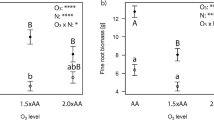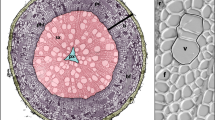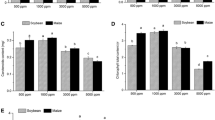Abstract
Ozone (O3) pollution and the availability of nitrogen (N) and phosphorus (P) in the soil both affect plant photosynthesis and chlorophyll (Chl) content, but the interaction of O3 and nutrition is unclear. We postulated that the nutritional condition changes plant photosynthetic responses to O3. An O3-sensitive poplar clone (Oxford) was subject to two N levels (N0, 0 kg N ha− 1; N80, 80 kg N ha− 1), two P levels (P0, 0 kg P ha− 1; P80, 80 kg P ha− 1) and three levels of O3 exposure (ambient concentration, AA; 1.5 × AA; 2.0 × AA) over a growing season in an O3 free air controlled exposure (FACE) facility. The daily change of leaf gas exchange and dark respiration (Rd) were investigated at mid-summer (August). Chl a fluorescence was measured three times in July, August and September. At the end of the growing season, Chl content was measured. It was found that Chl content, the maximum quantum yield (Fv/Fm), Chl a fluorescence performance index (PI) and gas exchange were negatively affected by elevated O3. Phosphorus may mitigate the O3-induced reduction of the ratio of photosynthesis to stomatal conductance, while it exacerbated the O3-induced loss of Fv/Fm. Nitrogen alleviated negative effects of O3 on Fv/Fm and PI in July. Ozone-induced loss of net photosynthetic rate was mitigated by N in medium O3 exposure (1.5 × AA). However, such a mitigation effect was not observed in the higher O3 level (2.0 × AA). Nitrogen addition exacerbated O3-induced increase of Rd suggesting an increased respiratory carbon loss in the presence of O3 and N. This may result in a further reduction of the net carbon gain for poplars exposed to O3.




Similar content being viewed by others

References
Appenroth K-J, Stöckel J, Srivastava A, Strasser RJ (2001) Multiple effects of chromate on the photosynthetic apparatus of Spirodela polyrhiza as probed by OJIP Chl fluorescence measurements. Environ Pollut 115:49–64
Arevalo CBM, Bhatti JS, Chang SX, Sidders D (2011) Land use change effects on ecosystem carbon balance: from agricultural to hybrid poplar plantation. Agric Ecosys Environ 141:342–349
Asada K (1999) The water–water cycle in chloroplasts: scavenging of active oxygens and dissipation of excess photons. Ann Rev Plant Physiol Plant Mol Biol 50:601–639
Awad J, Stotz HU, Fekete A, Krischke M, Engert C, Havaux M, Berger S, Mueller MJ (2015) 2-cysteine peroxiredoxins and thylakoid ascorbate peroxidase create a water–water cycle that is essential to protect the photosynthetic apparatus under high light stress conditions. Plant Physiol 167:1592–1608
Bowen HJM (1979) Environmental chemistry of the elements. Academic Press, London
Braun S, Achermann B, De Marco A, Pleijel H, Karlsson PE, Rihm B, Schindler C, Paoletti E (2017) Epidemiological analysis of ozone and nitrogen impacts on vegetation—critical evaluation and recommendations. Sci Tot Environ 603–604:785–792
Bryant JP, Chapin FS III, Klein DR (1983) Carbon/nutrient balance of boreal plants in relation to vertebrate herbivory. Oikos 40:357–368
Bussotti F, Desotgiu R, Cascio C, Pollastrini M, Gravano E, Gerosa G, Marzuoli R, Nali C, Lorenzini G, Salvatori E, Manes F, Schaub M, Strasser RJ (2011) Ozone stress in woody plants assessed with chlorophyll a fluorescence. A critical reassessment of existing data. Environ Exp Bot 73:19–30
Christersson L (2010) Wood production potential in poplar plantations in Sweden. Biomass Bioener 34:1289–1299
Cooper OR, Parrish DD, Ziemke J, Balashov NV, Cupeiro M, Galbally IE, Gilge S, Horowitz L, Jensen NR, Lamarque J-F, Naik V, Oltmans SJ, Schwab J, Shindell DT, Thompson AM, Thouret V, Wang Y, Zbinden RM (2014) Global distribution and trends of tropospheric ozone: anobservation-based review. Elem Sci Anth 2:000029
Cotrozzi L, Remorini D, Pellegrini E, Guidi L, Nali C, Lorenzini G, Massai R, Landi M (2017) Living in a Mediterranean city in 2050: broadleaf or evergreen “citizens”? Environ Sci Pollut Res. https://doi.org/10.1007/s11356-017-9316-7
Crutzen PJ (1970) The influence of nitrogen oxides on the atmospheric ozone content. Q J Roy Meteorol Soc 96:320–325
Desai S, Nak D, Cumming JR (2014) The influence of phosphorus availability and Laccaria bicolor symbiosis on phosphate acquisition, antioxidant enzyme activity, and rhizospheric carbon flux in Populus tremuloides. Mycorrhiza 24:369–382
Farage PK, Long SP (1995) An in vivo analysis of photosynthesis during short-term O3 exposure in three contrasting species. Photosyn Res 43:11–18
Feng Z, Niu J, Zhang W, Wang X, Yao F, Tian Y (2011) Effects of ozone exposure on sub-tropical evergreen Cinnamomum camphora seedlings grown in different nitrogen loads. Trees 25:617–625
Fenn ME, Baron JS, Allen EB, Rueth HM, Nydick KR, Geiser L, Bowman WD, Sickman JO, Meixner T, Johnson DW, Neitlich P (2003) Ecological effects of nitrogen deposition in the western United States. Bioscience 53:391–403
Ferrar PJ, Osmond CB (1986) Nitrogen supply as a factor influencing photoinhibition and photosynthetic acclimation after transfer of shade-grown Solanum dulcamara to bright light. Planta 168:563–570
Fusaro L, Palma A, Salvatori E, Basile A, Maresca V, Karam EA, Manes F (2017) Functional indicators of response mechanisms to nitrogen deposition, ozone, and their interaction in two Mediterranean tree species. PloS one 12:e0185836
Häikiö E, Freiwald V, Silfver T, Beuker E, Holopainen T, Oksanen E (2007) Impacts of elevated ozone and nitrogen on growth and photosynthesis of European aspen (Populus tremula) and hybrid aspen (P. tremula × Populus tremuloides) clones. Can J For Res 37:2326–2336
Han S-H, Kim D-H, Lee J-C, Kim P-G (2009) Effects of fertilization on physiological parameters in American scamore (Platanus occidentalis) during ozone stress and recovery phase. J Ecol Field Biol 32:149–158
Harmens H, Hayes F, Sharps K, Mills G, Calatayud V (2017) Leaf traits and photosynthetic responses of Betula pendula saplings to a range of ground-level ozone concentrations at a range of nitrogen loads. J Plant Physiol 211:42–52
Hoosbeek MR, Lukac M, van Dam D, Godbold DL, Velthorst EJ, Biondi FA, Peressotti A, Cortufo MF, de Angelis P, Scarascia-Mugnozza G (2004) More new carbon in the mineral soil of a poplar plantation under free air carbon enrichment (POPFACE): cause of increased priming effect? Glob Biogeochem Cycles 18:GB1040. https://doi.org/10.1029/2003GB002127
Hoshika Y, Watanabe M, Inada N, Koike T (2013) Model-based analysis of avoidance of ozone stress by stomatal closure in Siebold’s beech (Fagus crenata). Ann Bot 112:1149–1158
Hoshika Y, Carrari E, Zhang L, Carriero G, Pignatelli S, Fasano G, Materassi A, Paoletti E (2018) Testing a ratio of photosynthesis to O3 uptake as an index for assessing O3-induced foliar visible injury in poplar trees. Environ Sci Pollut Res 25:8113–8124
Kalaji HM, Schansker G, Ladle RJ, Goltsev V, Bosa K, Allakhverdiev SI, Brestic M, Bussotti F, Calatayud A, Dąbrowski P, Elsheery NI, Ferroni L, Guidi L, Hogewoning SW, Jajoo A, Misra AN, Nebauer SG, Pancaldi S, Penella C, Poli DB, Pollastrini M, Romanowska-Duda ZB, Rutkowska B, Serôdio J, Suresh K, Szulc W, Tambussi E, Yanniccari M, Zivcak M (2014) Frequently asked questions about chlorophyll fluorescence: practical issues. Photosyn Res 122:121–158
Kato MC, Hikosaka K, Hirose T (2002) Photoinactivation and recovery of photosystem II in Chenopodium album leaves grown at different levels of irradiance and nitrogen-availability. Funct Plant Biol 29:787–795
Kitao M, Löw M, Heerdt C, Grams TEE, Häberle K-H, Matyssek R (2009) Effects of chronic elevated ozone exposure on gas exchange responses of adult beech trees (Fagus sylvatica) as related to the within-canopy light gradient. Environ Pollut 157:537–544
Kitao M, Kamatsu M, Yazaki K, Kitaoka S, Tobita H (2015) Growth overcompensation against O3 exposure in two Japanese oak species, Quercus mongolica var. crispula and Quercus serrata, grown under elevated CO2. Environ Pollut 206:133–141
Koerselman W, Meuleman AFM (1996) The vegetation N:P ratio: a new tool to detect the nature of nutrient limitation. J Appl Ecol 33:1441–1450
Koricheva J (2002) The carbon-nutrient balance hypothesis is dead; long live the carbon-nutrient balance hypothesis? Oikos 98:537–539
Larcher W (2003) Physiological plant ecology, 4. Springer-Verlag, New York
Lewis JD, Strain BR (1996) The role of mycorrhizas in the response of Pinus taeda seedlings to elevated CO2. New Phytol. 133:431–443
Marschner H (2011) Marschner’s mineral nutrition of higher plants, 3rd edn. Academic Press, Cambridge
Marten H, Konrad KR, Dietrich P, Roelfsema RG, Hedrich R (2007) Ca2+ -dependent and -independent abscisic acid activation of plasma membrane anion channels in guard cells of Nicotiana tabacum. Plant Physiol 143:28–37
Matyssek R, Sandermann H (2003) Impact of ozone on trees: an ecophysiological perspective. In: Esser K, Lüttge U, Beyschlag W, Hellwig F (eds) An ecophysiological perspective. Progress in Botany, vol 64. Springer-Verlag, Berlin, pp 349–404
Matyssek R, Clarke N, Cudlín P, Mikkelsen TN, Tuovinen JP, Wieser G, Paoletti E (2013) Climate change, airpollution and global challenges: understanding and perspectives from forest research. In: Krupa SV (ed) Developments in environmental science. Elsevier, Amsterdam, p 622
Maurer S, Matyssek R (1997) Nutrition and the ozone sensitivity of birch (Betula pendula). II. Carbon balance, water-use efficiency and nutritional status of the whole plant. Trees 12:11–20
Maurer S, Matyssek R, Günthardt-Goerg MS, Landolt W, Einig W (1997) Nutrition and the ozone sensitivity of birch (Betula pendula). I. Responses at the leaf level. Trees 12:1–10
Mills G, Pleijel H, Malley CS, Sinha B, Cooper O, Schultz M, Neufeld HS, Simpson D, Sharps K, Feng Z, Gerosa G, Harmens H, Kobayashi K, Saxena P, Paoletti E, Sinha V, Xu X (2018) Tropospheric ozone assessment report: present day tropospheric ozone distribution and trends relevant to vegetation. Elem Sci Anth 6:47. https://doi.org/10.1525/elementa.302
Ollinger SV, Aber JD, Reich PB, Freuder RJ (2002) Interactive effects of nitrogen deposition, tropospheric ozone, elevated CO2 and land use history on the carbon dynamics of northern hardwood forests. Glob Chan Biol 8:545–562
Ormrod DP, Adedipe NO, Hofstra G (1973) Ozone effects on growth of radish plants as influenced by nitrogen and phosphorus nutrition and by temperature. Plant Soil 39:437–439
Paoletti E (2005) Ozone slows stomatal response to light and leaf wounding in a Mediterranean evergreen broadleaf, Arbutus unedo. Environ Pollut 134:439–445
Paoletti E, De Marco A, Beddows DCS, Harrison RM, Manning WJ (2014) Ozone levels in European and USA cities are increasing more than at rural sites, while peak values are decreasing. Environ Pollut 192:295–299
Paoletti E, Materassi A, Fasano G, Hoshika Y, Carriero G, Silaghi D, Badea O (2017) A new-generation 3D ozone FACE (free air controlled exposure). Sci Total Environ 575:1407–1414
Pell EJ, Sinn JP, Johansen CJ (1995) Nitrogen supply as a limiting factor determining the sensitivity of Populus tremuloides Michx. to ozone stress. New Phytol 130:437–446
Peng Y, Chen G, Chen G, Li S, Peng T, Qiu X, Luo J, Yang S, Hu T, Hu H, Xu Z, Liu L, Tang Y, Tu L (2017) Soil biochemical responses to nitrogen addition in a secondary evergreen broad-leaved forest ecosystem. Sci Rep 7:2783. https://doi.org/10.1038/s41598-017-03044-w
Peñuelas J, Sardans J, Rivas-Ubach A, Janssens IA (2012) The human-induced imbalance between C, N and P in Earth’s life system. Glob Chan Biol 18:3–6
Schulze ED (1989) Air pollution and forest decline in a spruce (Picea abies) forest. Science 244:776–783
Sicard P, De Marco A, Troussier F, Renou C, Vas N, Paoletti E (2013) Decrease in surface ozone concentrations at Mediterranean remote sites and increase in the cities. Atmos Environ 79:705–715
Stevenson FJ, Cole MA (1999) Cycles of soil (carbon, nitrogen phosphorus sulfur, micronutrients). John Wiley and Sons Publishers, Hoboken
Strasser RJ, Srivastava A. Tsimilli-Michael M (2000) The fluorescence transient as a tool to characterize and screen photosynthetic samples. In: Yunus M, Pathre U, Mohanty P (eds) Probing photosynthesis: mechanisms, regulation and adaptation. Taylor and Francis, London, pp 445–483
Strasser RJ, Tsimilli-Michael M, Qiang S, Goltsev V (2010) Simultaneous in vivo recording of prompt and delayed fluorescence and 820-nm reflection changes during drying and after rehydration of the resurrection plant Haberlea rhodopensis. Biochim Biophys Acta 1797:1313–1326
Suetsugu N, Takami T, Ebisu Y, Watanabe H, Iiboshi C, Doi M, Shimazaki K (2014) Guard cell chloroplasts are essential for blue light-dependent stomatal opening in Arabidopsis. Plos one 9:e108374
Sutinen S, Wallin G, Karlsson PE, Skärby L, Selldén G (1998) Cell ultrastructure of needles from saplings of Norway spruce, Picea abies (L) Karst., exposed to ozone and low phosphorus supply in open-top chambers. Chemosphere 36:691–696
Sugai T, Kam D-G, Agathokleous E, Watanabe M, Kita K, Koike T (2018) Growth and photosynthetic response of two larches exposed to O3 mixing ratios ranging from preindustrial to near future. Photosynthetica 56:901–910
Thomas RB, Lewis JD, Strain BR (1994) Effects of leaf nutrient status on photosynthetic capacity in loblolly pine (Pinus taeda L.) seedlings grown in elevated atmospheric CO2. Tree Physiol 14:947–960
Tissue DT, Lewis JD (2010) Photosynthetic responses of cottonwood seedlings grown in glacial through atmospheric [CO2] vary with phosphorus supply. Tree Physiol 30:1361–1372
Tjoelker MG, Luxmoore RJ (1991) Soil nitrogen and chronic ozone stress influence physiology, growth and nutrient status of Pinus taeda L. and Liriodendron tulipifera L. seedlings. New Phytol 119:69–81
Utriainen J, Holopainen T (2001) Influence of nitrogen and phosphorous availability and ozone stress on Norway spruce seedlings. Tree Physiol 21:447–456
Utriainen J, Holopainen T (2002) Responses of Pinus sylvestris and Picea abies seedlings to limited phosphorus fertilization and treatment with elevated ozone concentrations. Scand J For Res 17:501–510
van Heerden PDR, Tsimilli-Michael M, Krüger GHJ, Strasser RJ (2003) Dark chilling effects on soybean genotypes during vegetable development: parallel studies of CO2 assimilation, chlorophyll a fluorescence kinetics O–J–I–P and nitrogen fixation. Physiol Plant 117:476–491
van Heerden PDR, Strasser RJ, Krüger GHJ (2004) Reduction of dark chilling stress in N2-fixing soybean by nitrate as indicated by chlorophyll a fluorescence kinetics. Physiol Plant 121:239–249
Vingarzan R (2004) A review of surface ozone background levels and trends. Atmos Environ 38:3431–3442
Warren CR (2011) How does P affect photosynthesis and metabolite profiles of Eucalyptus globulus? Tree Physiol 31:727–739
Watanabe M, Yamaguchi M, Iwasaki M, Matsuo N, Naba J, Tabe C, Matsumura H, Kohno Y, Izuta T (2006) Effects of ozone and/ or nitrogen load on the growth of Larix kaempferi, Pinus densiflora and Cryptomeria japonica seedlings. J Jpn Soc Atmos Environ 41:320–334
Watanabe M, Hoshika Y, Inada N, Koike T (2014a) Canopy carbon budget of siebold’s beech (Fagus crenata) sapling under free air ozone exposure. Environ Pollut 184:682–689
Watanabe M, Hoshika Y, Koike T (2014b) Photosynthetic responses of monarch birch seedlings to differing timings of free air ozone fumigation. J Plant Res 127:339–345
Whitfield CP, Davison AW, Ashenden TW (1998) The effects of nutrient limitation on the response of Plantago major to ozone. New Phytol 140:219–230
Wilkinson S, Davies W (2010) Drought, ozone, ABA and ethylene: new insights from cell to plant community. Plant Cell Environ 33:510–525
Wooliver RC, Marion ZH, Peterson CR, Potts BM, Senior JK, Bailey JK, Schweitzer JA (2017) Phylogeny is a powerful tool for predicting plant biomass responses to nitrogen enrichment. Ecology 98:2120–2132
Yamaguchi M, Watanabe M, Iwasaki M, Tabe C, Matsumura H, Kohno Y, Izuta T (2007) Growth and photosynthetic responses of Fagus crenata seedlings to O3 under different nitrogen loads. Trees 21:707–718
Zhang L, Xu H, Yang JC, Li WD, Jiang GM, Li YG (2010) Photosynthetic characteristics of diploid honeysuckle (Lonicera japonica Thunb.) and its autotetraploid cultivar subjected to elevated ozone exposure. Photosynthetica 46:87–95
Zhang L, Hoshika Y, Carrari E, Badea O, Paoletti E (2018) Ozone risk assessment is affected by nutrient availability: evidence from a simulation experiment under free air controlled exposure (FACE). Environ Pollut 238:812–822
Acknowledgements
This work was financially supported by National Natural Science Foundation of China (31711530648), University Nursing Program for Young Scholar With Creative Talents in Heilongjiang Province (UNPYSCT-2017023), the Fondazione Cassa di Risparmio di Firenze (2013/7956) and the LIFE15 ENV/IT/000183 project MOTTLES. We would like to thank Alessandro Materassi, Gianni Fasano, Moreno Lazzara, Lorenzo Bussotti, and Isaac Tasap for their support during the field work. We thank Matthew Haworth for the English proofreading.
Author information
Authors and Affiliations
Corresponding author
Rights and permissions
About this article
Cite this article
Zhang, L., Hoshika, Y., Carrari, E. et al. Effects of nitrogen and phosphorus imbalance on photosynthetic traits of poplar Oxford clone under ozone pollution. J Plant Res 131, 915–924 (2018). https://doi.org/10.1007/s10265-018-1071-4
Received:
Accepted:
Published:
Issue Date:
DOI: https://doi.org/10.1007/s10265-018-1071-4



